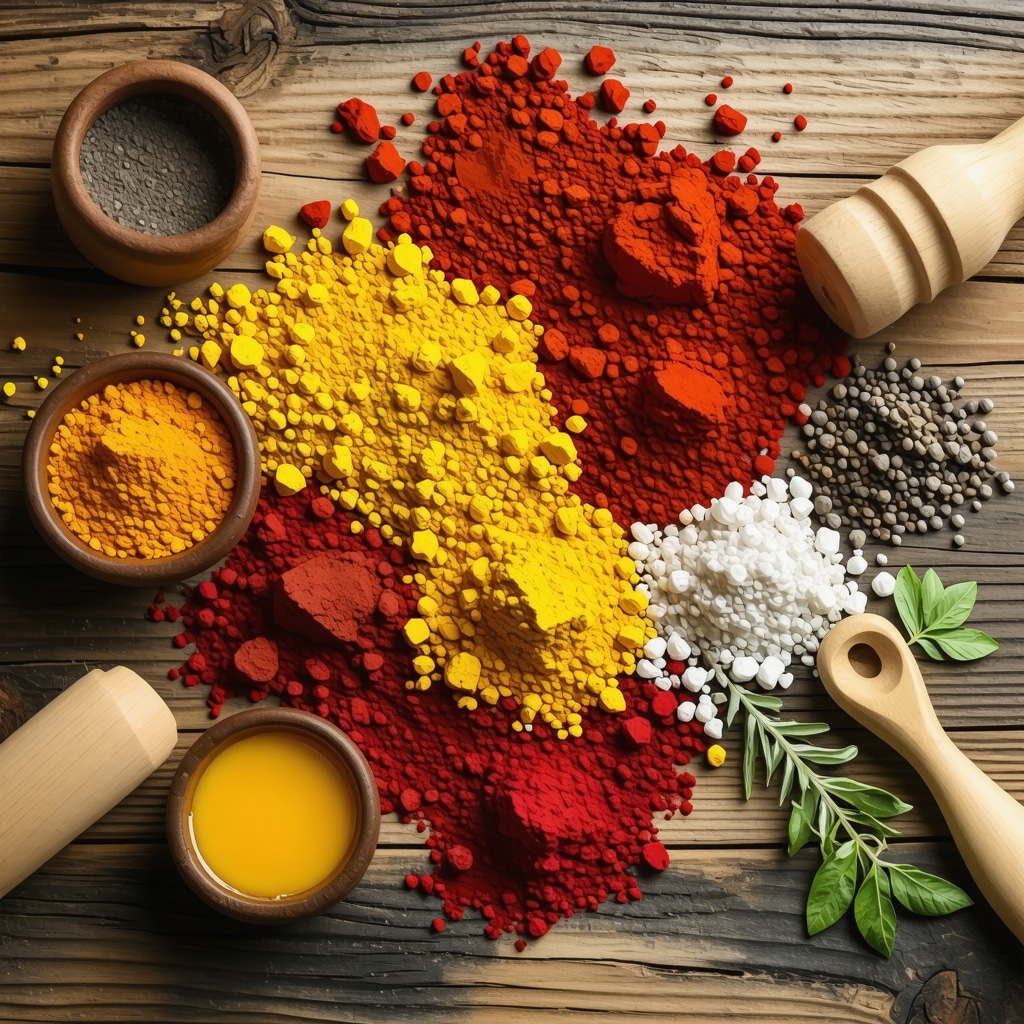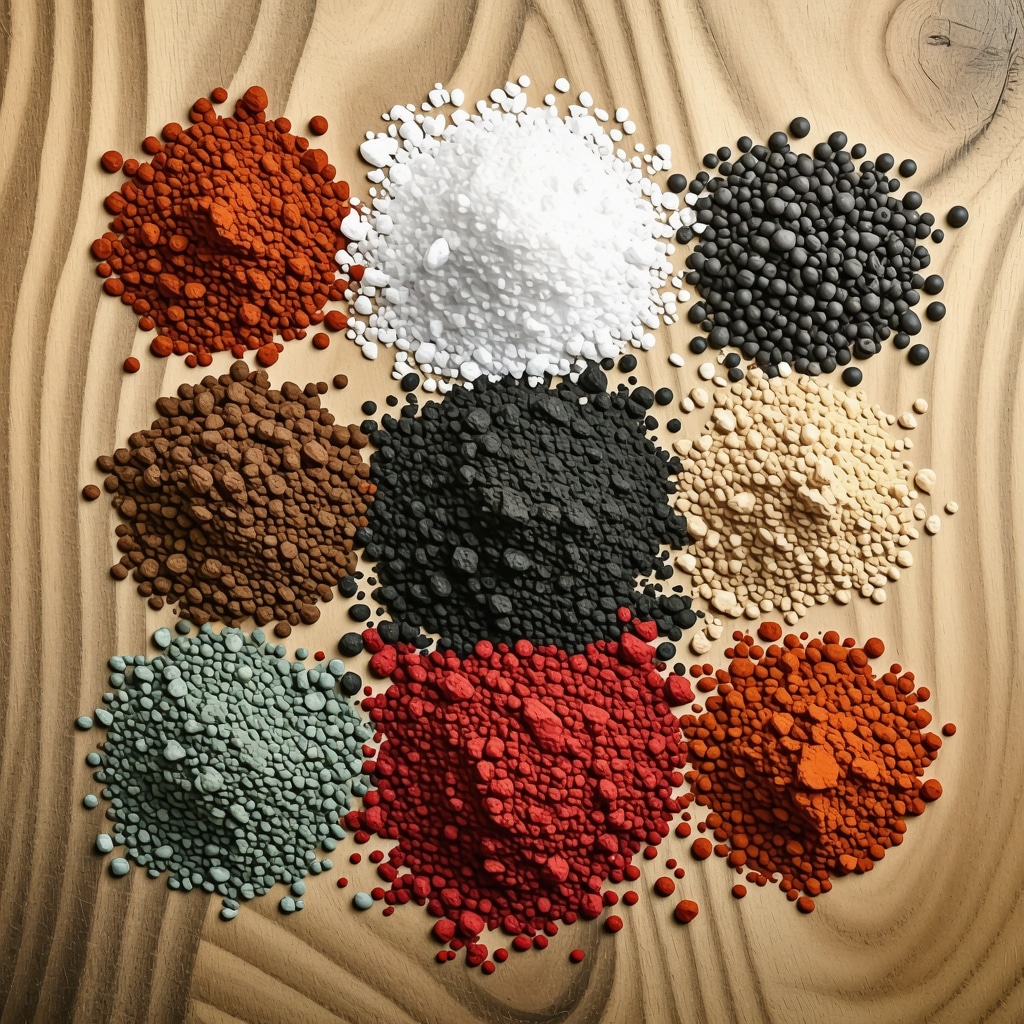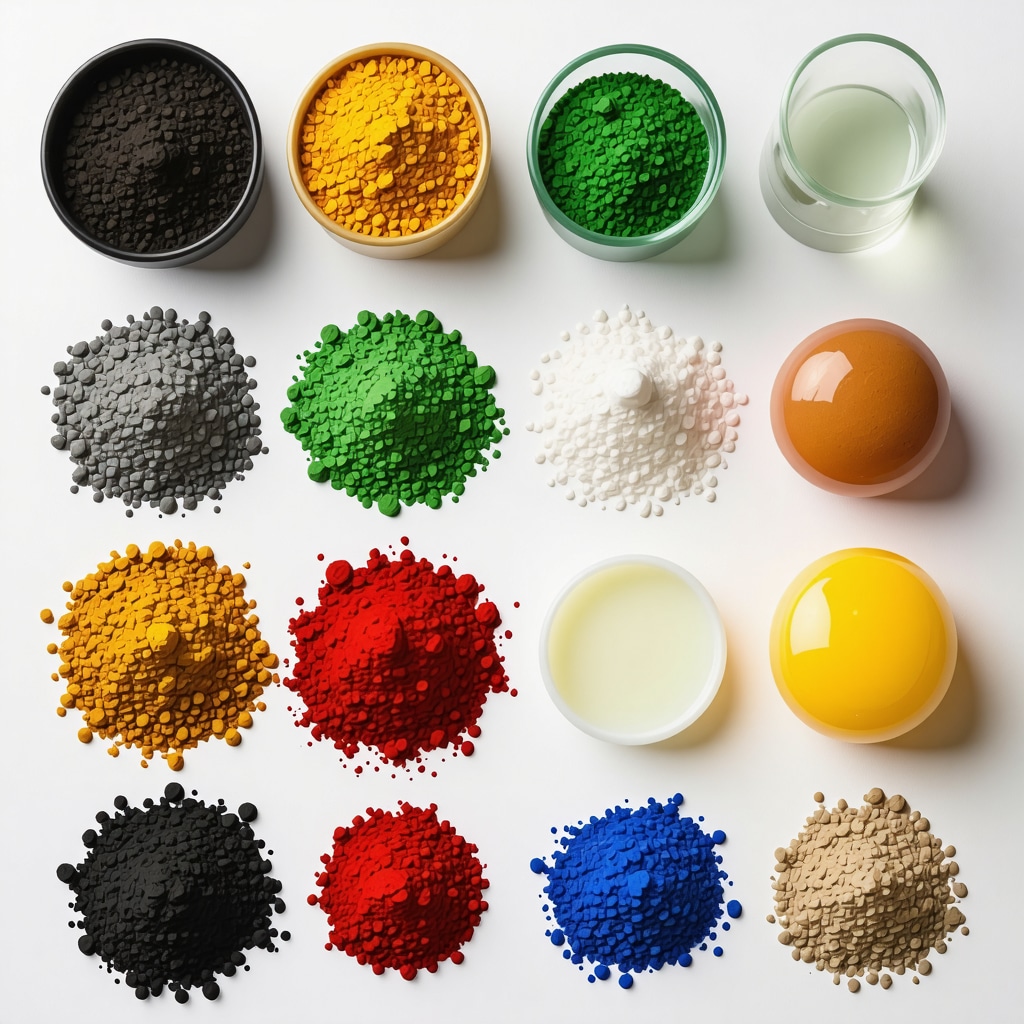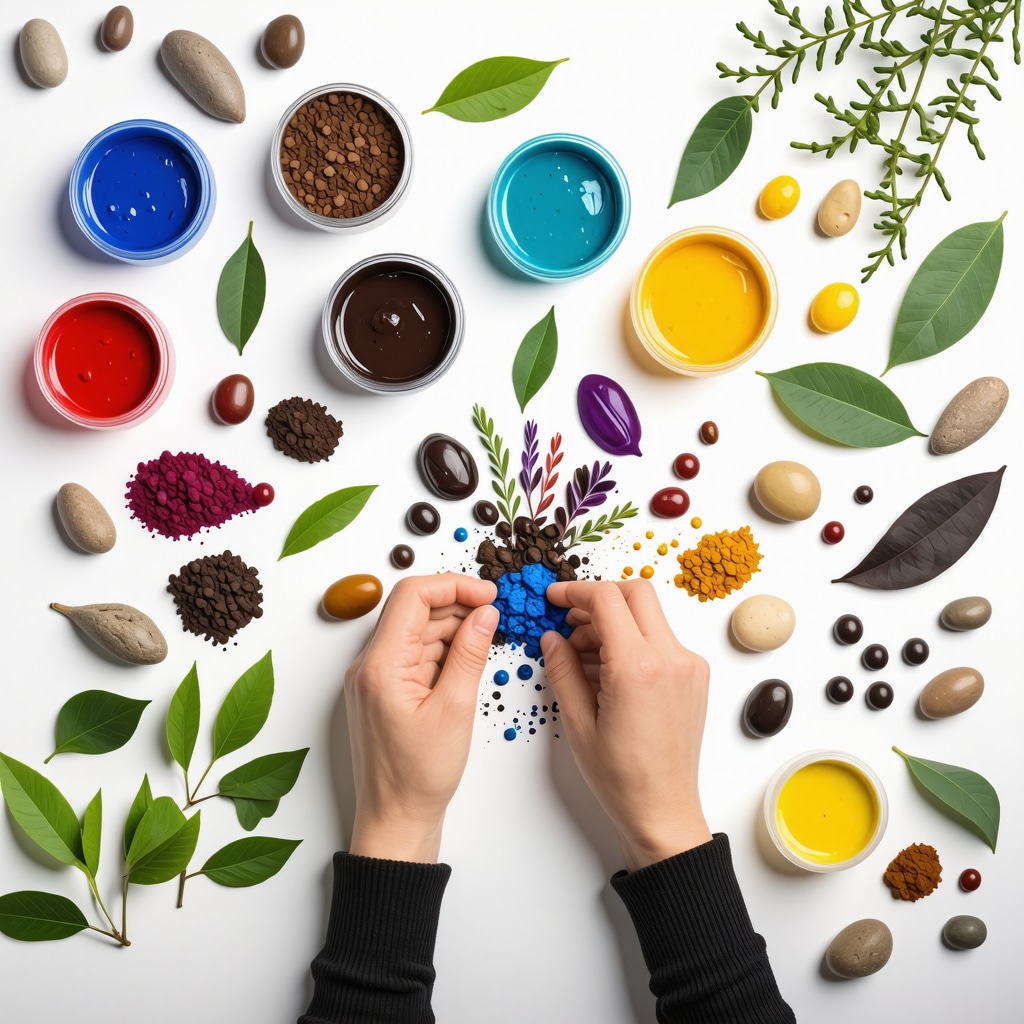How I Discovered the Magic of Natural Earth Paints
One lazy afternoon, as I sifted through a pile of garden soil, a sudden thought struck me: why not transform these humble earth tones into vibrant pigments for my art projects? That curiosity led me on a rewarding journey into creating natural earth paints. Using DIY pigments sourced from the environment, I found a way to connect more deeply with nature and give my artwork a unique, eco-friendly edge.
Harvesting Colors Straight From the Earth
Extracting pigments from natural soil, clay, and rocks is surprisingly simple and incredibly satisfying. I’ve gathered materials like red ochre, yellow clay, and charcoal from local spots, then ground them finely to create my pigments. Mixing these with natural binders such as egg yolk or plant-based gums gives me rich, lasting paints perfect for eco art. This process not only reduces reliance on commercial synthetic paints but also adds a personal touch that synthetic colors can’t replicate.
Why Choose DIY Natural Pigments Over Commercial Paints?
Beyond the environmental benefits, DIY natural pigments offer a deeper connection to the materials and my creative process. Each batch carries the unique signature of its origin, reflecting the landscape’s geology and history. Plus, using natural pigments aligns well with sustainable art practices I’ve embraced over the years. I often reference resources like the Handprint Guide to Natural Pigments for detailed insights into pigment preparation and safety, which helped me refine my techniques safely and effectively.
Transforming My Home with Earthy DIY Art Projects
Once I mastered making my own earth paints, I began experimenting with eco prints on fabric and creating wall art that brightened up my living space naturally. For those interested, there are fantastic ideas on unique DIY crafts to try for home décor that complement natural pigments beautifully. Sharing these projects with friends and family has been a joy, sparking conversations about sustainable creativity.
If you’ve ever played with natural pigments or are curious about starting, I’d love to hear your experiences or questions. Feel free to drop a comment below or explore more creative solutions for eco-friendly art and home décor. Let’s inspire each other to embrace the beauty of natural materials in our crafts!
Exploring the Science Behind Natural Earth Pigments
Understanding the mineral composition of your sourced earth pigments can dramatically enhance your paint-making skills. Iron oxides, for example, are responsible for the rich reds and yellows found in ochres, while manganese oxides produce deep browns and blacks. By experimenting with different soils and clays, you can create a spectrum of hues unique to your locale. This scientific approach not only deepens your appreciation but also helps in predicting pigment behavior in different binders and substrates.
How Can You Ensure the Longevity and Vibrancy of Your DIY Earth Paints?
Longevity and colorfastness are crucial for any artwork. To achieve this with natural pigments, it’s essential to properly process and purify your raw materials to remove organic matter that might degrade over time. Additionally, choosing the right binder is key; traditional options like egg tempera provide durable films, while plant gums offer flexibility but may require a fixative layer for protection. Testing your paint on various surfaces and under different light exposures can guide you toward the optimal formulation. For comprehensive safety and preparation guidelines, the Handprint Guide to Natural Pigments remains an authoritative resource.
For those keen on integrating natural pigments into textile projects, techniques like eco-printing and botanical dyeing can be enhanced by pre-treating fabrics with mordants derived from natural sources, ensuring better pigment adherence and color durability. Explore botanical dyeing techniques to complement your earth paint ventures.
Practical Tips for Collecting and Preparing Earth Pigments Responsibly
Ethical sourcing is paramount when harvesting natural pigments. Always collect small quantities from multiple locations to minimize environmental impact, and avoid protected areas. Once collected, drying your materials thoroughly before grinding prevents mold growth and ensures a finer pigment powder. Using a mortar and pestle or a mechanical grinder, aim for a consistent particle size to achieve smooth paint textures. This care in preparation translates directly into the quality and workability of your paints.
Moreover, combining your pigments with various natural binders—such as casein, honey, or tree resins—can yield different finishes and textures, expanding your creative toolkit. Each binder interacts uniquely with pigments, affecting drying times and glossiness; experimenting here can lead to bespoke finishes tailored to your artistic vision.
Integrating Natural Pigments into Modern DIY Home Decor
Natural earth paints aren’t just for traditional canvases—they can beautifully transform your living space. Consider applying them to wooden shelves, terracotta pots, or even creating custom wall murals that echo your local landscape’s palette. For inspiration on marrying natural pigments with DIY home improvement projects, browse innovative ideas on transforming your space with DIY home decor and smart solutions for modern living.
Sharing your unique creations online or hosting workshops can foster a community passionate about sustainable art. Your journey with natural pigments can inspire others to reconnect with the earth’s beauty through their crafts.
If you’re interested in further exploring this fascinating topic or have tips to share, please leave a comment or share this article with fellow eco-art enthusiasts. For more detailed guidance on crafting with natural materials, check out our creative solutions for beginners and advanced DIY guides.

The Intimate Relationship Between Soil and Color
One of the most fascinating aspects of working with natural earth pigments is realizing how intimately connected the colors are to their geographic origins. I’ve often found myself on weekend hikes, collecting small samples from different soil types, intrigued by how even subtle shifts in mineral content can produce dramatically different hues. This personal exploration not only enriches my palette but also weaves a deeper narrative into each piece I create—each pigment tells a story of place, time, and natural processes.
How Can Understanding Mineralogy Elevate Your Pigment Crafting?
For those eager to experiment beyond the basics, diving into the mineralogical composition of your pigments can unlock new creative potentials. Iron oxides, such as hematite and goethite, impart strong reds and yellows, while minerals like umber add browns with subtle greenish undertones. Recognizing these distinctions helps in predicting how pigments will behave when mixed or applied. I found Handprint’s comprehensive guide invaluable for understanding these nuances, especially their detailed explanations on pigment chemistry and lightfastness. This knowledge has empowered me to tailor my pigment preparation methods, ensuring vibrancy and permanence in my work.
Moreover, appreciating these mineralogical subtleties invites a more mindful approach to sourcing. Instead of random collection, I now seek out soils with specific compositions, turning pigment hunting into a kind of geological treasure hunt that deepens my connection to the land.
Balancing Tradition and Innovation in Natural Paint Making
While I cherish traditional binders like egg tempera and tree resins for their historical resonance and durability, I’ve also experimented with innovative, plant-based alternatives that align with modern sustainability goals. For example, incorporating aloe vera gel or flaxseed mucilage as binders offers new textures and drying properties, though they require careful testing to ensure stability. This blend of old and new techniques keeps the craft dynamic and responsive to contemporary environmental concerns.
In my quest to integrate natural pigments into home décor, I’ve been inspired by ideas on transforming your space with DIY home décor. Applying these paints to unconventional surfaces like reclaimed wood and natural fibers challenges me creatively and yields uniquely textured finishes that add warmth and authenticity to my living environment.
Reflections on the Sustainability and Community Impact of DIY Earth Paints
Beyond aesthetics and technique, crafting my own earth paints has become a meditation on sustainability and community. By minimizing reliance on synthetic materials and reducing packaging waste, I feel my art-making contributes in small but meaningful ways to environmental stewardship. Sharing my knowledge through workshops and online forums has connected me with a vibrant community of eco-conscious creators. It’s heartening to see how these shared values foster collaboration and mutual inspiration.
If you’re curious about exploring this path or have experiences with natural pigments to share, I warmly invite you to join the conversation. Engaging with fellow enthusiasts through comments or community groups can open new doors, whether you’re seeking advice or offering fresh ideas. For those starting out, the creative solutions for beginners provide a wonderful springboard into this rewarding craft.
As this exploration continues, I look forward to uncovering more about the interplay between nature, science, and art in the realm of natural earth pigments—an ongoing journey that continually renews my appreciation for the humble materials beneath our feet.

Unveiling the Molecular Alchemy of Soil-Derived Pigments
As my journey with natural earth pigments evolved, I became increasingly captivated by the molecular intricacies that govern pigment behavior. The subtle interplay of mineral structures and environmental factors, such as pH and moisture content, influences not only the chromatic qualities but also the stability and interaction of pigments with various binders. This nuanced understanding propelled me to experiment with soil amendments and controlled drying techniques to refine pigment consistency and vibrancy.
Such explorations led me to appreciate how the crystalline form of iron oxides, for instance, hematite versus magnetite, can affect opacity and hue intensity. This molecular perspective enriches the craft, transforming pigment making from a purely artisanal endeavor into a sophisticated dialogue between chemistry and creativity.
What Advanced Methods Can Enhance Pigment Purification and Stability?
To push the boundaries of pigment quality, I’ve integrated advanced purification methods like sedimentation and controlled calcination. Sedimentation allows finer clay particles and impurities to separate naturally, yielding purer pigment powders that produce smoother paint films. Calcination, the process of heating pigments at specific temperatures, can intensify color saturation and improve lightfastness but requires precision to avoid degradation.
Moreover, stabilizing pigments with natural antioxidants extracted from plant sources, such as rosemary or green tea, has shown promising results in slowing oxidative degradation. These techniques, detailed in scholarly works like the ACS Applied Materials & Interfaces study on natural pigment stabilization, have expanded my toolkit for creating durable, eco-friendly paints that stand the test of time.
Innovative Fusion: Blending Traditional Pigments with Modern Eco-Materials
In pursuit of marrying heritage and innovation, I’ve ventured into combining my earth pigments with emerging sustainable materials like bio-resins derived from algae and mycelium-based binders. These novel compounds offer unique textural qualities and biodegradability, aligning with my commitment to environmental stewardship.
Applying these composites in wall art and custom furniture pieces has opened new creative horizons, allowing for finishes that are both tactile and visually compelling. For inspiration on integrating such ideas into home environments, I recommend exploring transforming your space with DIY home décor, which showcases inventive applications leveraging natural materials.
Fostering a Knowledge-Sharing Ecosystem in Sustainable Art Practices
Beyond personal experimentation, I find profound fulfillment in nurturing a collective wisdom around natural pigment crafting. Through hosting interactive workshops and engaging in online forums, I have witnessed how sharing challenges and breakthroughs fosters a dynamic learning ecosystem. This communal approach not only democratizes access to sophisticated techniques but also amplifies the cultural resonance of sustainable artistry.
If you are passionate about deepening your expertise or have nuanced insights to share, I warmly encourage you to connect with our growing community. Engage through comments or join our discussions in the creative solutions for beginners space, where even seasoned practitioners exchange ideas and inspire one another.
Continuing this exploration promises to unravel yet more mysteries at the intersection of natural science and art, inviting us all to reimagine the humble earth pigments as vibrant conduits of culture, history, and innovation.

Things I Wish I Knew Earlier (or You Might Find Surprising)
The Nuance of Soil Color Variations Is a Journey, Not a Shortcut
When I first started collecting pigments, I expected predictable colors from certain soils. But I quickly learned that even small changes in mineral content or moisture could shift hues dramatically. This unpredictability is part of the joy and challenge — it means every batch is unique and tells a story about its origin. Embracing this has made my pigment hunting feel like a treasure hunt rather than a chore.
Natural Binders Can Be as Complex as the Pigments Themselves
I once assumed mixing a pigment with any natural binder would yield similar results. Reality taught me otherwise. Each binder — from egg tempera to plant gums or newer options like flaxseed mucilage — interacts differently, influencing drying time, texture, and durability. Experimentation is key, and keeping notes on what combinations work best for your projects saves frustration down the line.
Purification Techniques Matter More Than I Expected
Early on, I overlooked the importance of thoroughly purifying my pigments. Removing organic matter and achieving a fine, consistent particle size transformed the look and longevity of my paints. Advanced steps like sedimentation and even gentle calcination can elevate your pigment quality significantly, making your colors more vibrant and stable.
The Environmental Impact of Sourcing Requires Mindful Practices
Collecting earth pigments is a privilege tied deeply to nature. I learned that taking too much from one spot or disturbing sensitive environments isn’t sustainable. Spreading out collection sites and respecting protected areas ensures this craft remains viable and ethical. It’s a small step with a big impact that every eco-artist should consider.
Sharing Creativity Builds Community and Inspires Growth
Perhaps the most rewarding lesson has been how sharing my process and discoveries with others creates a ripple effect. Whether through workshops, online forums, or informal chats, connecting with fellow enthusiasts enriches the craft and leads to new ideas I might never have found alone.
Resources I’ve Come to Trust Over Time
The Handprint Guide to Natural Pigments (handprint.com) is a goldmine for anyone serious about understanding the chemistry and safety aspects of natural pigments. It’s thorough yet accessible, perfect for deepening your knowledge.
DIY Kutak’s Creative Solutions for Beginners (diykutak.com) offers practical, step-by-step guides that helped me take my natural pigment projects from idea to reality with confidence.
Botanical Dyeing Techniques and Eco-Printing (diykutak.com) is fantastic for those looking to expand their natural pigment skills into textiles and fabric art.
Innovative Home Decor Ideas with Natural Materials (diykutak.com) inspired me to apply earth paints beyond traditional canvases, turning everyday spaces into sustainable art showcases.
ACS Applied Materials & Interfaces Study on Natural Pigment Stabilization (acs.org) provided fascinating insights into advanced methods for enhancing pigment durability, bridging science and craft.
Parting Thoughts from My Perspective
Delving into the world of DIY natural earth paints has been more than an artistic endeavor — it’s a journey into the heart of nature’s palette and the science that underpins it. Each pigment carries a story of place and process, and crafting paints by hand has deepened my connection to the environment and my creative practice. By blending tradition with innovation, and mindful sourcing with community sharing, this craft becomes a living dialogue between earth and artist.
If you’re inspired to explore natural earth paints yourself, know that the path is as rewarding as the results. Whether you’re layering colors on canvas, refreshing your home décor with earthy tones, or experimenting with botanical dyeing, there’s a rich world to discover. Feel free to share your experiences or questions below — I’d love to hear your stories and continue this creative conversation together.


I love how this article highlights the deeply personal and environmental connection that comes with using natural earth pigments. I’ve dabbled in making my own pigments from local clay here in Sydney, and the unpredictability of colour truly is part of the allure and challenge. One thing that caught my attention was the variety of natural binders mentioned—I’ve always used egg yolk but recently tried flaxseed mucilage with mixed results. It seems like each binder brings a distinct character to the paint, affecting drying times and finish.
Also, the ethical sourcing advice really resonates with me; I used to be a bit too enthusiastic in collecting samples but have now shifted towards smaller amounts from diverse spots to avoid impacting any particular area. It’s a delicate balance but a worth-while one.
What strategies have others found useful when experimenting with different binders to achieve consistent durability in their natural paints? And has anyone integrated these DIY pigments into textile projects successfully beyond eco-printing? I’m keen to learn about diverse applications and any tips on maintaining longevity, especially in different environmental conditions.
Regarding Harriet’s insightful questions about binders and textile applications, I’ve had some experience blending traditional egg tempera with small amounts of tree resins to improve both flexibility and durability, especially for artworks exposed to variable humidity. This combination seems to form a sturdier paint film without compromising the natural aesthetic. When it comes to textiles beyond eco-printing, I’ve tried mixing finely ground earth pigments with natural gum Arabic and applying them as fabric paints. Pre-treating fabrics with alum mordants definitely helps with pigment adherence and colour longevity. However, I found that adding a light fixative layer, like a diluted beeswax finish, offers additional protection, especially for items exposed to sunlight or frequent washing. I agree that each binder interacts uniquely and takes time to master. I’m curious if others have experimented with newer plant-based binders like aloe vera gel or flaxseed mucilage for textile applications? How did you address challenges related to drying or washing fastness? Sharing experiences like these helps us all refine our craft and deepen our sustainable practices.
I really appreciate the careful thought Harriet and Eleanor have put into the intricacies of natural binders and their impact on paint durability. From my own experience experimenting with natural earth pigments here in Melbourne, I’ve found that the choice of binder can completely change not only the texture and drying time but also the longevity of the paint, especially in variable climates. For textile projects, I dabbled with flaxseed mucilage as a binder, but like Harriet, my results were mixed—mainly due to its sensitivity to humidity and slower drying times. What helped me was layering the fabric with a diluted casein solution before applying the pigment mix; this extra prep seemed to enhance pigment adherence and washfastness. Also, sealing finished pieces with a light application of natural beeswax added a protective finish without compromising breathability. I’m curious if others have tried combining traditional binders like egg tempera with plant-based additives to balance durability and eco-friendliness? How do you find these blends perform over the long term, particularly on textiles exposed to regular use or washing? It’s incredible how much nuance there is in these natural materials, and sharing these practical tips could really help us all create lasting, sustainable art.
I really appreciate the rich connection to nature this post highlights in using natural earth pigments. The notion that each pigment carries a unique story linked to its locale resonates deeply. I’ve spent some time collecting and grinding my own pigments from clay deposits near Perth, and the unpredictable shifts in hue, depending on moisture or mineral variance, truly do feel like uncovering hidden stories within the earth. One challenge I’ve encountered is balancing the natural variability with the consistency needed for more structured projects. Regarding the issue of binders, I’ve experimented with honey combined with a bit of tree resin to create a flexible yet durable paint, which has worked well for some smaller artworks on wood panels. However, it’s definitely a trial-and-error process to find the right binder that complements your pigment’s particular texture and enhances longevity. I wonder if others have found success blending traditional binders like egg tempera with small amounts of natural resins or even plant mucilage to improve both flexibility and resilience? Also, has anyone explored ways to stabilise colour vibrancy when using DIY pigments for furniture or home décor items that endure daily wear? Sharing practical tips for maintaining durability in more utilitarian applications would be really valuable here.
This article really resonated with me, especially the idea of connecting deeper with nature through pigment sourcing. I’ve found that experimenting with local soils here in Adelaide always introduces an element of surprise—sometimes unexpectedly vibrant, other times more subtle, which adds a layer of richness to my art. One challenge I’ve faced is stabilising these earthy hues for practical use in interior decorating, where durability and consistent colour are key. I’ve been exploring different natural binders like casein and even homemade linseed oil varnishes, but the results vary depending on the environment and application. I’d be interested to hear if others have tried eco-friendly sealants or fixatives to improve longevity without compromising the natural look and feel. Also, I wonder how incorporating mineralogical knowledge, such as the presence of hematite or goethite, might help refine the shades and durability? It’s inspiring to see how science and art intertwine in this craft—could this approach be expanded to develop more predictable earthy colour palettes? Would love to exchange thoughts on sustainable methods for ensuring eco pigments stand the test of time in both fine art and practical home projects.
Reading about the creative process of transforming local soils into vibrant pigments genuinely inspires me. I’ve recently started experimenting with similar techniques here in Brisbane, and I find that the subtle mineral differences really do tell a story about a place. One challenge I’ve faced is maintaining consistency in batches, especially because natural sources can vary so much from one day to the next. I’m curious, does anyone have tips on stabilising natural pigments so that they retain their hues over time, especially in humid climates like ours? Also, I’ve been exploring the use of natural binders beyond egg yolk, such as plant gums and even honey, but I’d love to hear more about successful combinations that improve durability—has anyone had experience with plant resins or other natural fixatives? I think integrating those might help create more resilient artworks suitable for daily exposure both indoors and outdoors. Sharing these practical solutions can really help us all deepen our sustainable art practice while preserving the unique beauty of earth-derived colours. Looking forward to hearing everyone’s insights on stabilising and preserving natural earth paints in different environments.